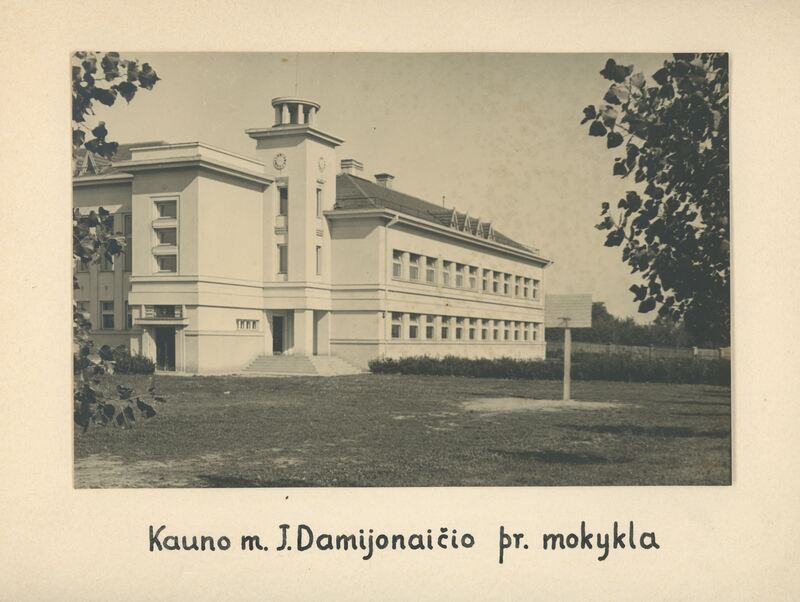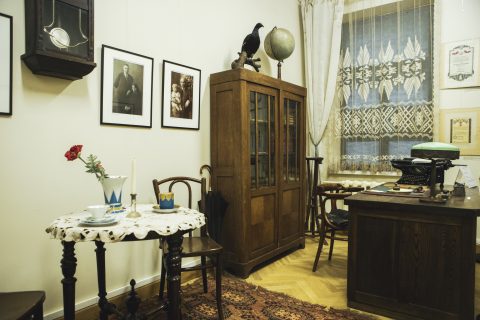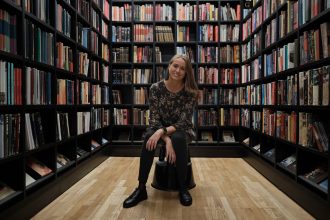This year, the Museum of Lithuanian Education History along with its Central Teachers’ reading room – the predecessor of the Vincas Kudirka Public Library in Kaunas – are celebrating their 100th anniversary. On this occasion, the museum and the library joined forces to present a tour dedicated to its founder, titled On the Path of Vincas Ruzgas’ Light. People, who take the tour discover buildings in the center of Kaunas and the old town, where a museum and a library were located during the interwar period. And the sharp-penned Paulius Tautvydas Laurinaitis, who is returning to the pages of Kaunas Full of Culture, offers another route: the elementary schools built in the city at that time.
Perhaps the biggest priority in independent Lithuania was education. The basis of its development strategy was the establishment of the primary school network, which aimed to cultivate the intellectual potential of the young generation and ensure basic literacy, thus helping the progress of the state. Since the early days of the country’s existence, compulsory primary education has been established as an aspiration at the state level, although it turned into real actions a bit later. Compulsory primary education was finally established in the temporary capital in 1928.
Kaunas took over 21 primary schools from the former German occupation government, with a total of 43 classes and only 2218 students. City’s demographic was rapidly changing, so the network had to be improved as soon as possible. Some schools were settling in rented premises, a number of these buildings were built by private individuals for this purpose. Perhaps the most interesting phenomenon of that time was brick monumental school buildings developed by the municipality according to the latest trends. So, let’s look at them.

The construction of the first brick building, specifically designed for the primary school function, in the temporary capital, which was to become a kind of symbol of the advanced education system, started in 1925. With only one-ninth of the required amount (50 thousand litas) and the municipality not getting into an agreement with the ministry about the remaining part, only a part of the building was initially implemented, and classes were held here the following year. The 23rd Lithuanian elementary school which consisted of four grades started to work. The construction took quite a long time, and the need for elementary education in a rapidly growing city was only increasing. The original design of the two-story building created by the former head of the city’s Construction Department, Feliksas Vizbaras, had to be adjusted by his colleague Antanas Jokimas during construction. A three-story primary school named in honor of Vincas Kudirka (currently Vincas Kudirka pro-gymnasium, Trakų St. 39) opened its doors in 1929.
At the turn of the decade, the municipality of the city built two schools. Both of them were externally and internally representing the ideas of the modernist era. Based on the knowledge acquired during his business trip in Sweden, A. Jokimas designed a school in Aušros Street (now Jonas Jablonskis Gymnasium, Aušros St. 3), which was desperately needed for the residents of the growing Žaliakalnis district. He also built a school for Jewish children near the Nemunas (now Juozas Naujalis Music Gymnasium on Karaliaus Mindaugo Avenue). Both schools were equipped with facilities that later became mandatory: gyms, rooms for handicrafts, canteens, apartments for the main building staff and showers. Both schools are harmoniously integrated into their plots.
Yet, the schools of Kaunas were still rather overcrowded, especially in the ever-growing Žaliakalnis. In 1934, the modern school in Aušros Street already had 50 percent more students than planned, which meant that 50 or more children had to cram in one classroom. In addition, in 1936 the duration of primary education has been extended to six years. For this reason, the construction of a new, even more modern elementary school for the children of Žaliakalnis started in Jonavos Street (currently a building belonging to the Lithuanian Army, P. Kalpoko St. 93). The spot for it was chosen based on practical reasons because the current P. Kalpoko Street was already in municipality’s plans, and it was precisely in the sawmills and other companies operating in the Neris valley that a considerable number of the poorer inhabitants of the northern and western parts of Žaliakalnis worked.
The Jewish children, who needed a new primary school in the Old Town, were not forgotten. Parallel to the Lithuanian bastion of education on Jonavos Street, a six grade Jewish primary school on Nemuno St. (now Kaunas Senamiestis Pro-gymnasium, Nemuno St. 12). Although the street had a bad reputation, there was a lack of space for new buildings in the densely built-up area of the historical Old Town, and after the bus station was moved to another place, a rather big empty lot had emerged.
Working-class Šančiai, which at that time competed with cities like Šiauliai in terms of population, received a modern primary school (now Motiejus Valančius school-kindergarten, Kranto 5-oji St. 7), built on an irregular plot in the chaotic environment of Krantai.
The projects of all these schools were prepared by the architect Stasys Kudokas, who worked in the Construction Department of the Kaunas City Municipality at the time, and eventually became one of the most famous figures in the field of architecture at the time. Another school designed by him emerged on the hills of Aleksotas in 1937. The imposing environment, the palace of the Aleksotas Airport, which was one of the gates to the city and the monumental Institute of Physics and Chemistry of Vytautas Magnus University, sort of obliged the school to be architecturally exceptional. The main entrance of the school that received a name of J. Damijonaitis, was decorated with a distinctive turret. By the way, this is the only brick school of that time that has not survived. Just like the aforementioned VMU building, it was blown up during the Second World War.

In 1938, the municipality was already overseeing 42 primary schools with 11 248 pupils in their 253 grades. In addition, 18 private schools with 64 grades and another 1,526 students enrolled in them, strengthened the city’s education capacity. During the first 20 years of Independence, 13 new primary schools were built (another five were completely renovated), 11 of which appeared after the introduction of compulsory primary education. However, there was still a shortage. The largest primary school in Lithuania was built in Šančiai in 1939 (now Kaunas Adult and Youth Education Center, Sandėlių St. 7), which had 15 grades and a reading room. After the famous collapse of the municipal bus garage, Stasys Kudokas’ duties in designing municipal buildings had already been taken over by another architect – well-known to the architecture enthusiasts of today – Feliksas Bielinskis, who also prepared a project for a monumental building on Sandėlių Street, the implementation of which cost almost a million litas at the time.
F. Bielinskis also prepared projects for the last two schools of the independence period in Kaunas. One of them was a school for the children of Žaliakalnis’ residents (now Gediminas Sports and Health Promotion Gymnasium, Aukštaičių St. 78). Another huge building in the city centre was completed during the years of occupation. And although the building of the primary school on what was the Ugniagesių Street then, was destined to become a new home for future musicians (now Kaunas Juozas Gruodis Conservatory, J. Gruodis St. 6), its facades are still decorated with panels containing municipality’s initials: KMS. They can also be seen on some schools of the 1930s.




